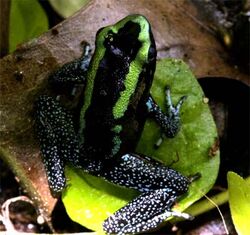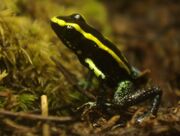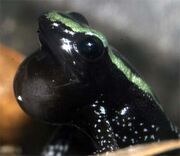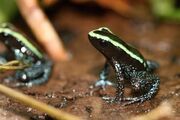| Kokoe poison dart frog | |
|---|---|
 | |
| Physical description | |
| Binomial name | Phyllobates aurotaenia |
| Habitat | Tropical rainforest. |
| Lifespan | 8-15+ years. |
| Average Size | 3.2 cm (1.3 in) |
| Average weight | 3 grams |
| Diet | Insectivorous. |
| Conservational Status | |
| Status | Near threatened. |
| IUCN status | 3.1 |
| Scientific classification | |
| Phylum | Chordata |
| Class | Amphibia |
| Order | Anura |
| Family | Dendrobatidae |
| Genus | Phyllobates |
| Species | P. aurotaenia |
| Distribution | |
| Distribution of species | Northern Colombia. |
The Kokoe poison dart frog, Phyllobates aurotaenia, is a species of poison dart frog. It is endemic to northern Colombia near the border with Panama. The Kokoe poison dart frog is the fourth-most toxic of its genus and has recently been split into P. aurotaenia and another, as yet unnamed species. It is threatened by habitat loss, pollution, and chytridiomycosis.
Poison[]
The Kokoe poison dart frog is the third-most toxic of the poison dart frogs. The Kokoe poison dart frog primarily secretes allopumiliotoxin 267A through its skin, similar to the other members of the lugubris subgenus. Like the members of the Phyllobates bicolor species group, however, it also secretes batrachotoxin through its skin, though in smaller amounts.
Phyllobates aurotaenia are lethally toxic. Simply touching an agitated adult frog can induce serious and often life-threatening neurological symptoms including high fever, loss of muscle control, convulsions, and even paralysis. Eating an adult P. aurotaenia may be fatal almost immediately, even for fairly large animals.
Although wild specimens are deadly, captive Kokoe poison dart frogs lose their toxicity quickly. This suggests that they, too, take their toxins from their insect-rich diet.
Description[]

Captive male specimen.
Phyllobates aurotaenia is an average-sized poison dart frog. Male specimens reach 3 centimetres in length; females are slightly larger and may reach 3.2 centimetres long. Females are buliker and more robust than males as they will fight for mates just as the males will.
As with most dendrobatid frogs, the Kokoe poison dart frog is brilliantly coloured and patterned. Always predominantly black, P. aurotaenia has two yellow or green dorsal stripes running from the tip of its nose to just above its cloaca. The black or dark brown legs are peppered with white dots, and the underside is black. Recently a former morph of the Kokoe poison dart frog, with red dorsal stripes and no dots on the legs, was discovered to be a genetically distinct species.
Behaviour[]
The Kokoe poison dart frog is one of the most intelligent anurans known. It can distinguish between humans, and it is capable of remembering locations that suit it well weeks after visiting them. P. aurotaenia, like most poison dart frogs, lives in small groups of four to seven with an average of five; captive aurotaenia can be kept in smaller or larger groups.
. Like many poison dart frogs, aurotaenia groups are territorial and will attempt to fend off rival groups by calling.

Wild male specimen calling.
P. aurotaenia gather to breed.This is one of the more audible of thepoison dart frogs and has a call often described as beautiful and bird-like. Once a male catches the attention of a male, he courts her by gently carressing her body. If she is sufficiently impressed, she will allow the male to lead her to a suitable place for egg deposition. Amplexus in P. aurotaenia takes place up to 3 metres from the ground, and fertilization is external.
The male guards the eggs, which are laid on the leaf litter. He will protect the developing tadpoles from predators and even moisten them with the water from his own bladder. The eggs hatch after approximately two weeks, and the tadpoles form a tight ball around the male's waist. He then transports them to bromeliads or water-filled tree holes where he deposits the tadpoles individually (as they are highly cannibalistic). When they metamorphose into froglets, they are led by the male to an existing group. It is unknown whether this group is always the same in which the father was raised.
In captivity[]

Two captive specimens.
Like P. vittatus, the Kokoe poison dart frog is an excellent beginner's species. As a vivarium subject, this frog is an active animal that will make use of vertical space. Kokoe dart frogs are highly social frogs that require high humidity, cool temperatures, and larger prey items than many dart frogs. They engage in wrestling behavior, but much less frequently than other dart frogs.